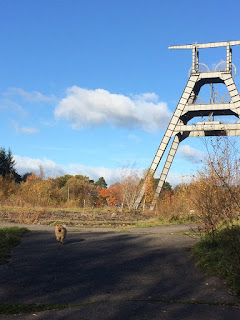 One thing I remembered about Muirkirk as we drove along the A70 through Lugar was that the OS map I keep in the car stops around Cronberry, and as I hadn't got around to buying the one that actually covers Muirkirk, today's walk was a bit of a wing and a prayer. I *had* looked up the relevant section of the River Ayr walkway as it starts at neighbouring Glenbuck, and I had a vague notion that we needed to turn towards the campsite, but beyond that... As we neared the village Mrs A sensed my uncertainty so I parked the car and marched confidently along the footpath towards, um, a signpost.
One thing I remembered about Muirkirk as we drove along the A70 through Lugar was that the OS map I keep in the car stops around Cronberry, and as I hadn't got around to buying the one that actually covers Muirkirk, today's walk was a bit of a wing and a prayer. I *had* looked up the relevant section of the River Ayr walkway as it starts at neighbouring Glenbuck, and I had a vague notion that we needed to turn towards the campsite, but beyond that... As we neared the village Mrs A sensed my uncertainty so I parked the car and marched confidently along the footpath towards, um, a signpost.Fate intervened and the signpost turned out to say "walker's carpark", the starting point for several fantastically well signed paths.
 Muirkirk is a long way inland - it's pretty much the last bit of Ayrshire before you reach the desert badlands of Lanarkshire - and it's high up, so it has had quite a bit of snow in the last few days. The dogs were delighted, especially Mac.
Muirkirk is a long way inland - it's pretty much the last bit of Ayrshire before you reach the desert badlands of Lanarkshire - and it's high up, so it has had quite a bit of snow in the last few days. The dogs were delighted, especially Mac.We didn't get a chance to go far (see comments above re map...) but we had enough daylight to enjoy a stunning walk. Passing a ruined house and an empty field, information signs told us that this was the home and HQ of John Loudoun MacAdam's tar works - a hub of invention back in the late 18th century. In fact, that muddy track may lay claim to have been the first 'tarmacked' road in the world! A cairn a few yards further on commemorates MacAdam (using the stones from his factory - hence the now empty field).
 Following the path further onto the moorland and we could have been anywhere - Cairngorm, the Highlands - but with the complete absence of other people. It's a stunningly beautiful and easily accessible wilderness (and a good trip if you're thinking about getting a taste of Ayrshire from the East - just about an hour and a half from Edinburgh, down the A70)
Following the path further onto the moorland and we could have been anywhere - Cairngorm, the Highlands - but with the complete absence of other people. It's a stunningly beautiful and easily accessible wilderness (and a good trip if you're thinking about getting a taste of Ayrshire from the East - just about an hour and a half from Edinburgh, down the A70) Of course, being Ayrshire, the wilderness is never quite as wild as it looks - there are signs of man's poking around at every turn. The land around Muirkirk is boggy, and Kames was the site of at least one pit working. In several places, the ground has given way into soggy holes, and there are multiple warning signs advising that you stick to the path (I'm not sure that the sheep in the neighbouring field can read, perhaps they are just naturally wary of holes that weren't there before...)
Of course, being Ayrshire, the wilderness is never quite as wild as it looks - there are signs of man's poking around at every turn. The land around Muirkirk is boggy, and Kames was the site of at least one pit working. In several places, the ground has given way into soggy holes, and there are multiple warning signs advising that you stick to the path (I'm not sure that the sheep in the neighbouring field can read, perhaps they are just naturally wary of holes that weren't there before...)So enjoy, take a map, and don't fall down the "industrial archaeology"...












